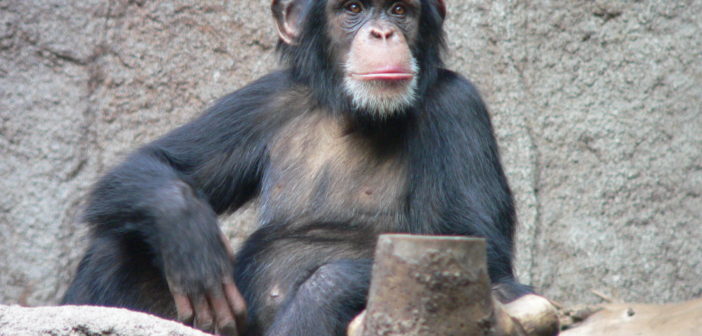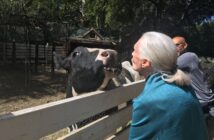Hilda Tresz is a true chimp champion. As the Behavioral Enrichment and International Welfare Coordinator at the Phoenix Zoo, she has been responsible for transforming the lives of over 85 captive chimpanzees.
Hilda is responsible for overseeing the Zoo’s behavioral management programs and has served as a mentor and researcher. She has dedicated her career to ensuring that captive primates as well as hundreds of other species of animals have the proper behavioral enrichment to keep them happy, healthy and curious in their environments.
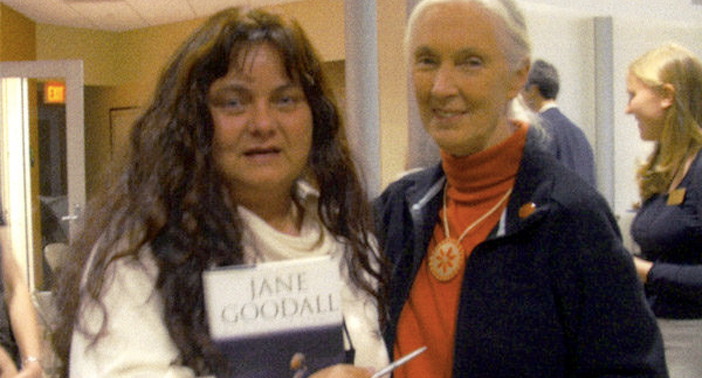
In 2007, Hilda graced the Jane Goodall Institute with her expertise and became a volunteer; using her expertise to host workshops and lectures, and working with zoos to enhance the psychological well-being of chimpanzees.
Because of her skill, dedication and persistence, her diplomatic approach to sometimes complex situations, and because she truly cares, Ms. Tresz has been able to help many chimpanzees and zoos in many parts of the world
– Dr. Jane Goodall
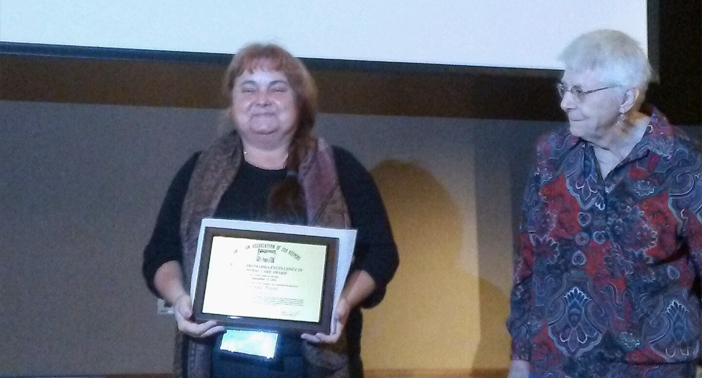 Hilda has accomplished so much good in her nearly 30 years of wildlife care, and as a testament to that has been awarded the American Association of Zookeepers’ Lee Houts Environmental Excellence Award for her work. She has also become a published author writing for National Geographic, and has a feature length documentary titled One Week to Change in the works which will be coming out soon.
Hilda has accomplished so much good in her nearly 30 years of wildlife care, and as a testament to that has been awarded the American Association of Zookeepers’ Lee Houts Environmental Excellence Award for her work. She has also become a published author writing for National Geographic, and has a feature length documentary titled One Week to Change in the works which will be coming out soon.
Though her job is a tough one, she believes this was always what she was meant to do. Read below to learn more about Hilda, her work and her precious chimpanzees!
What drew you to a career in animal care? When did you first know you wanted to work with animals?
I was born and raised as a typical city girl, except for the summers, when I was sent for three months to my grandparents in the village. I cannot remember anything but being surrounded by crops and animals, running barefooted everywhere, eating fruit from the trees, feeding chickens and cleaning the barns. I still remember that wonderful barn smell – the smell of fresh straw, the cows’ breath and milk! I think this is how it started. I always knew I was going to work with animals.
How did you decide to work with chimpanzees? What makes chimps special? How is working with them different from working with other animals?
Well, I worked with a family of chimpanzees at the Budapest Zoo helping out in the primate area when needed, but my first love was actually bears and small mammals. After my husband and I came to the U.S. (Chicago), we couldn’t work in our profession for almost a year. We decided to send out about 200 resumes and waited. The Primate Foundation of Arizona hired us to work with 85 chimpanzees in their non-profit organization, and my life changed. While some more species are extremely intelligent, in my opinion, chimpanzees are the closest to humans from a behavioral standpoint. Their social skills, politics, cunning, love, hate, compassion, lying, cheating, grieving, kissing, hugging, killing, protecting, caring, altruism, etc., completely reminds me of humans. Their short term memory is better than humans; they can also carry out a conversation with you, lie to you or convince you of things or make up new definitions if they don’t know the word. When you work with a chimpanzee, you don’t know what to believe.
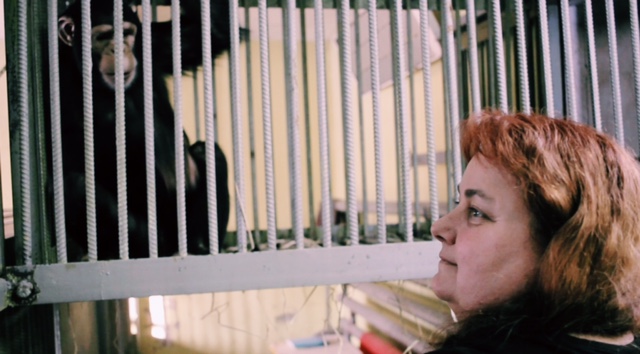
When you work with 85 of them, your life will never be the same! You don’t know how you will survive dealing with so many of them at the same time. It is you who needs to try to fit in. They don’t like you yet; you’re new and they will test you on a daily basis. You will be covered with bedding, fecal and leftover food, spit, vomit, you will be grabbed, yelled at and there is nothing you can do about it. Not until they get to know and respect you. If you yell or mentally and physically abuse them, you will accomplish nothing. They will just fear you and hate you. They are patient; they will get back at you as their skilled teamwork is astonishing. Instead of trying to change them, you are the one who needs to accommodate. If you are nice to them, and never abuse them, you might get lucky and experience the magic that has kept me going for years. Deep love, trust, understanding and friendships you never thought could exist between humans and another species. Everything is on a whole new level, and suddenly you can’t image not working with them.
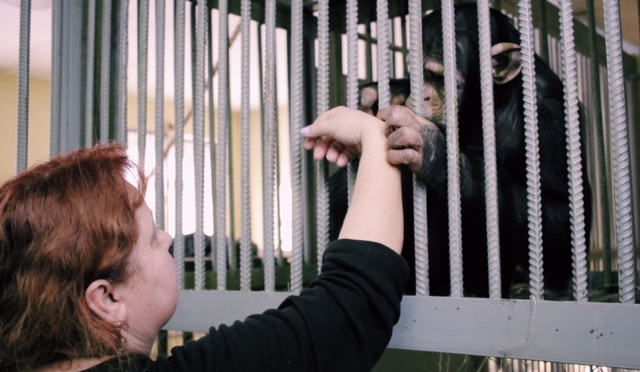
Why is it important for animals in zoos, especially chimps, to receive environmental enrichment?
The goal of Behavioral Enrichment is to encourage animals to use their natural abilities, promote species-appropriate behaviors, offering a sense of control of their environment by allowing them to make choices and have new experiences.
In the wild, animals live in a complex and diverse habitat, exhibit a wider range of natural, species-typical behaviors and can make most of their own choices (sleep, forage, breed, bath, fight, etc.). Therefore, they have a sense of control of their environment. In captivity, animals are confined in relatively small habitats with reduced complexity and increased predictability. They also exhibit a far less range of natural, species-typical behaviors, have limited choices and their choices are often decided for them. It’s our homocentric bias to assume that we know what is best for them. As an example, we put them on feeding schedules, altering such things as foraging time, their choice of food and their eating patterns. We move them around, introduce to and separate them from other animals, choose who they need to breed with, clean their exhibits, medicate or even euthanize them if needed. Therefore animals have less of a sense of control of their environment.
Hediger (1950) discussed the misconception that wild animals are “free” when in fact they are constrained by many behaviorally imposed barriers (access to breeding partners, food and shelter availability, etc). In his opinion, neither wild nor zoo animals are truly free. However, one could argue that an animal with the most choices and most control has the most “freedom.” By providing enrichment, animals can choose when, how and where to interact or choose not to interact at all.
What differentiates a good zoo habitat from a poor one?
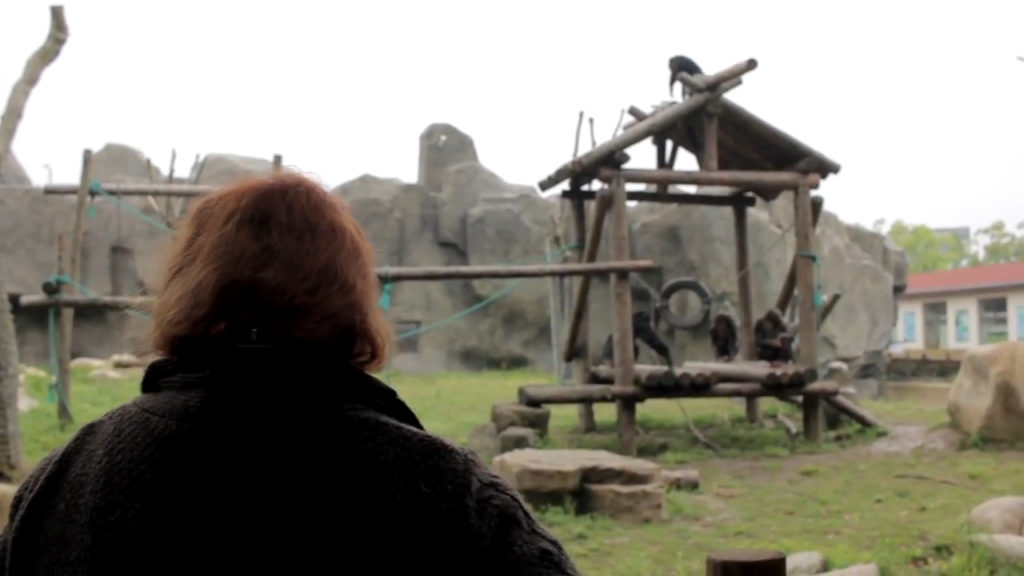
Functionality. Most of the time, people think they cannot provide a good habitat due to lack of money, because their cages are too small or they create a beautiful exhibit that pleases the human eye, yet the animal can’t utilize it. The question should be whether the habitat can be brought to a level when it serves the animal’s need. Does it utilize 3-D or is a small floor space all the animal has? If the cage is made from concrete, the animal needs to be taken off of it by either breaking it up or being covered with deep substrate so the animal can choose to be on it or not. It is an unhealthy, unyielding surface that the animal cannot manipulate. Does the animal have privacy? It can be done in various ways while the visitors still can view the animal. What can the animals do inside that cage? Can it forage (not eat!) for hours? Can it use proper motor skills? Is the animal within the right social group?
What is your favorite part of your job? What work are you most proud of?
When I see the animals getting relief. When I see an animal how it used to sit by itself in an empty, concrete cage, inactive and lethargic, and after the changes are made, it is somersaulting in the fresh hay, foraging peacefully for hidden diet in straw, chewing on fresh browse, playing with its new toys or just resting, finally, happily in something comfortable as opposed to concrete. That’s my favorite part of my job. Or, when I see an infant chimpanzee, running across the cages after the door is opened while his new surrogate mother opens her arms and they would hug the longest time, and they just keep hugging as if they want to be sure that they can never be separated – it is a moment I am most proud of. You just stand there, quietly soaking in the moment and you know they will be O.K. from now on.
What, in your opinion, is the greatest threat to chimpanzees, and how can the conservation work being done in zoos help save chimps in the wild?
Besides the well-known conservation efforts (overpopulated earth, habitat loss, bush market, illegal wildlife trafficking, etc.) the chimps are in real danger of lack of knowledge of caregivers. Education (as always) is the key. For example, if people would understand that chimpanzees cannot learn how to breed if they are taken from their parents and the group, maybe wildlife trafficking would slow down a bit. Many zoos desire “baby” animals being exhibited because this is what the visitors would like to see most. So, they keep taking infants away from the wild at a very early age to supply the demands, not knowing that if chimpanzees cannot actually observe the behavior, they will never learn it. Mating (just as in humans) is not instinct but a learned behavior. More zoos are complaining that their chimpanzees wouldn’t mate, transferring them all over to other zoos thinking that if they are introduced to different chimpanzees, then they may have offspring. They don’t understand that the problem might be as simple as they don’t know how to mate.

Another problem is the many solitary males in captivity. They won’t introduce them with others because they think the chimps would harm or even kill each other especially when it comes to infants. In the wild, many documents underline these behaviors, but in captivity things are a bit different. Most of the time, I find that they are just big “teddy bears;” they only fight to a certain extent and they are gentle with infants. But, because they are aggressive with the keepers, people think they would behave the same with their conspecific. Again, not realizing that their aggression comes from being kept in solitary confinement in the first place. Another problem is the lack of knowledge of how to introduce chimpanzees together, or breeding chimpanzees that are different subspecies which ruins the genepool and the integrity of the subspecies. If this continues, we will end up with no chimpanzees left in the wild, many chimpanzees in captivity without proper social skills and no knowledge of how to properly breed, raise or protect their offspring.
How has Dr. Goodall inspired your work?
In my line of work, I think it’s safe to say I have seen it all. I have seen animals suffering in the most horrible circumstances all over the world. I have seen animals (not just chimpanzees) starved, hurt, abused, or mentally ill, quietly going insane in a corner somewhere in an empty, ridged cage. I have seen vacant eyes you can never forget. Unfortunately, the pictures keep rolling in your mind over and over years after years (or, at least in my mind) until I can fix the problems. Sometimes I feel hopeless, helpless, angry and although my family and friends try to emphasize with me I truly believe no one really understands what I’m going through – except Jane. So I wrote to her, telling her about the problems, asking for advice, help, clarity and solutions. And she listened to my sadness, my frustration, my pain and turmoil.
She understands it because she went through it all. She is there for me when I’m just about ready to go out of my mind because I’m losing faith and keep wondering how I’m going to fix it all. I don’t know how she does it, but she always finds the time to answer my questions the minute she has computer access. No matter what country she is in, how busy her schedule is or how tired she is, she hits that reply button and calms me down. She looks for solutions. She grounds me. She pushes me to do more. She is there for me. She is my friend. When I talk to her, I feel like I can do it all and there is nothing wrong – like I have just seen a new spring day full of flowers, sunshine and birds chirping.
How are you working with the Jane Goodall Institute?
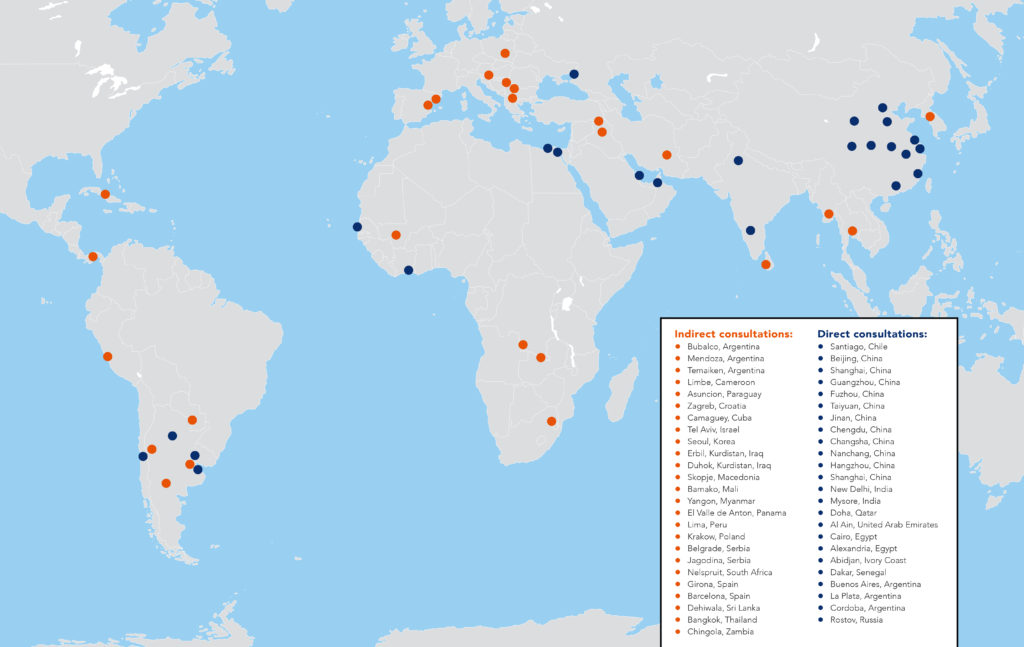
All of the places around the world where Hilda has either directly or indirectly helped improve the lives of wildlife in zoos.
I became a mentor for the Jane Goodall Institute in 2007. Dr. Landau (former Director of ChimpanZoo) asked if I would be willing to work with the ChimpanZoo program and help improve the lives of captive chimpanzees. ChimpanZoo has a mission to study captive chimpanzees and enrich their lives in a variety of ways, whilst also educating people about the behavior and needs of these apes. Some zoos have very little money; others have little experience in dealing with such intelligent and complex primates. It is important for zoo administrators and keepers to realize that even very simple activities – such as finding and using a thin stick to dip into a tub of yogurt situated beyond the bars of the cage – can help alleviate crippling boredom.
Over the last couple of years, my responsibilities have expanded. Initially, I was mostly developing enrichment programs. Now I’m also helping zoos better understand and practice basic husbandry procedures, initiating training programs for keepers, resolving behavioral issues and advising and helping on ways of introducing chimpanzees to each other – some of whom have been traumatized and have a variety of behavioral problems. I cannot emphasize it enough; education is the key. I mentor zoo staff, interns, volunteers and have worked with zoos all over the world to enhance the psychological well-being of chimpanzees and other species.
To stay up to date with Hilda’s work, follow A Week to Change on Facebook and keep reading about her adventures on National Geographic’s Voices Blog.


